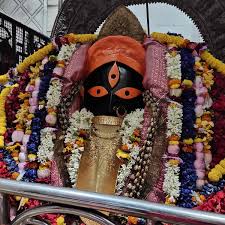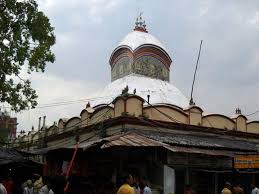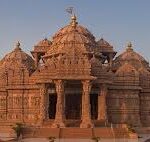Visit to Kolkata Kali
The Kalighat Kali Temple Or Kolkata Kali is located in Kolkata, West Bengal, India. It is one of the 51 Sati Piths, where the little toe of the right foot of Goddess Sati rested.

According to mythology, Atmaram Bambra Chari, while meditating in the deep forest here, built an idol of the goddess here on the instructions of Kali temple and started worshiping it. He took the help of Nigiri Parbat Brahmaanand. Who was an accomplished man. Bambra Nanda took the rock 12 cubits long and 2 cubits wide from the Nilgiris mountain and brought it to Kalighat in Dai Babal. Vishwakarma himself came from heaven to make the statue of kali.

The temple was first built by Vasant Roy, uncle of King Pratap Aditya of Jessore. Later in 1809 Savarna Roy Chowdhury rebuilt this temple. About 30,000 rupees were spent and 596 bighas of land were dedicated to Devakali
Baba Loknath Bambra Chari and Beni Madhava first came to Kalighat temple to learn their Siddha Sadhana. Rani Rasmani, the founder of Dakshineswar temple used to come here to visit the goddess
The head crown, 4 arms, umbrella on the head, tongue made of gold, many devotees benefited and offered to the goddess.
The Ganga flows through the temple, the temple is 90 feet high from the Ganges bed. It has Radha Krishna Temple, Nakuleshwar Shiva Temple
In 1862, a shrine was built near the temple, which is known as Keoratala shrine. The final rites of Siddhahasta people, Mani Rishis are done here
Kalighat temple opening hours are 5 am to 2 pm and 4 pm to 10.30 pm. Exceptions on special days like Durga Puja, Kali Puja, Snan Yatra festival, these days are crowded with devotees.
there is a metro station called kalighat metro station
There are many flower shops, pooja paraphernalia shops and many pandas in the temple premises
History Of Temple
The Kalighat Kali Mandir is also mentioned in Lalmohan Bidyanidhis’ ‘Sambanda Nirnoy’. The current temple is 200 years old and was built in the nineteenth century. Raja Basanta Roy, King of Jessore, built the original temple.
Around 1570 Padmabati Devi, the mother of Laksmikanta Roy Choudhury of Sabarna Roy Choudhury family, claimed to have a divine vision and discovered the right toe of Sati in a lake called Kalikunda in Kalighat. This gave Kalighat the status of one of the 51 Shakti Peeths.
When the British were consolidating their power in India, the area was part of the Dihi Panchannagram the East India Company purchased from Mir Jafar in 1758, after defeating Siraj-ud-Daulah in Battle of Plassey.
These villages then were part of the suburbs of Calcutta and were set amid forested land. Slowly the forests were cleared, and the suburbs were created which got assimilated into the growing city.
The deity of Kali in the Kalighat temple is unique, because it has not been designed following the common pattern of other Kali images. The existing idol of touchstone was crafted by two saints – Atmaram Giri and Brahmananda Giri. The deity features three huge eyes, four gold hands and most importantly a long gold tongue. It is said to be based on the idol of Mata Bhuvaneshwari, the Kuladevi of Sabarna Roy Choudhury family.
In the past the place was known as Kali Kshetra. Many people relate the origin of the name of the city to that of the temple. However, opinions of experts vary as there is no documented proof of the genesis of the name.
It is believed that the name of the village may have been derived from the Kali Kshetra or was derived from the local Bengali term for the creek that formed the southern boundary of the village. Creek is known as ‘Khal’ and digging is called ‘Kata’. Joining of the two is believed to have resulted in the nomenclature.


